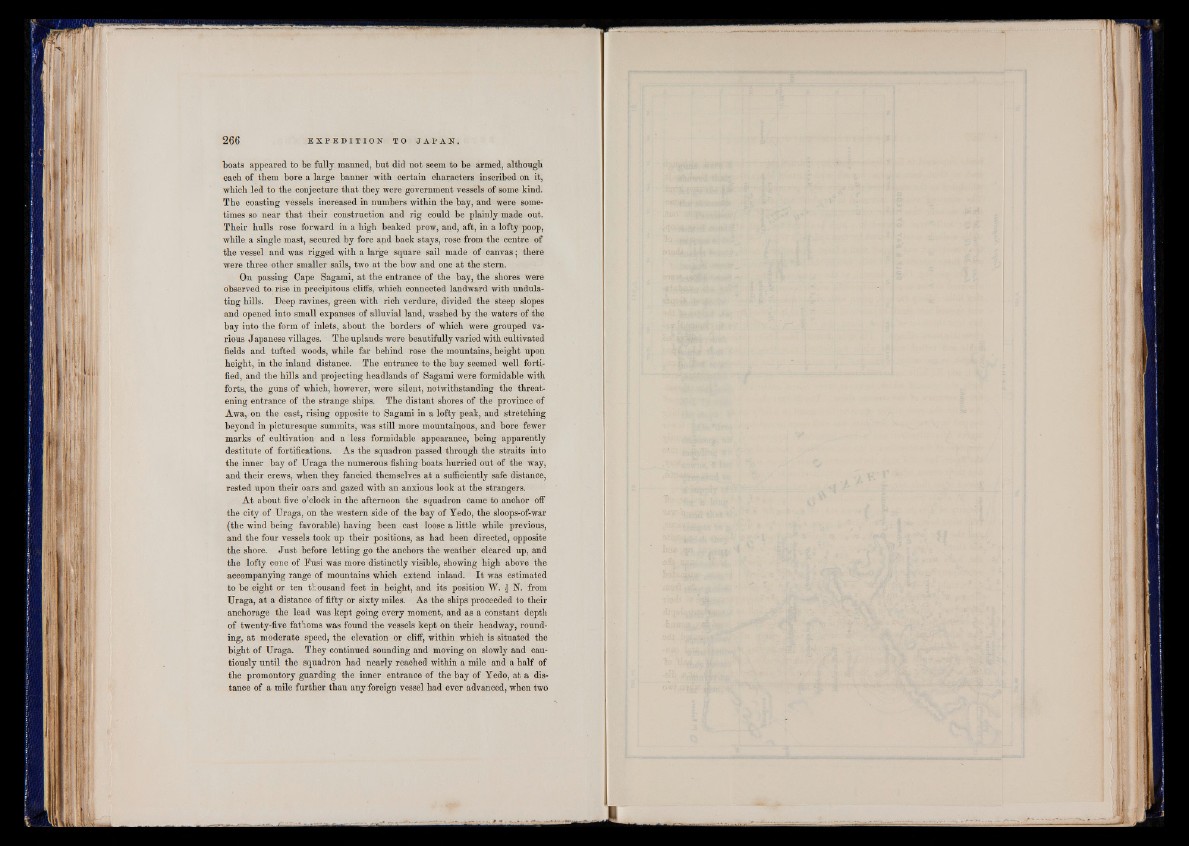
266 E X P E D I T I O N TO J A P A N .
boats appeared to be fully manned, but did not seem to be armed, although
each of them bore a large banner with certain characters inscribed on it,
which led to the conjecture that they were government vessels of some kind.
The coasting vessels increased in numbers within the bay, and were sometimes
so near that their construction and rig could be plainly made out.
Their hulls rose forward in a high beaked prow, and, affc, in a lofty poop,
while a single mast, secured by fore and back stays, rose from the centre of
the vessel and was rigged with a large square sail made of canvas; there
were three other smaller sails, two at the bow and one at the stern.
On passing Cape Sagami, at the entrance of the bay, the shores were
observed to rise in precipitous cliffs, which connected landward with undulating
hills. Deep ravines, green with rich verdure, divided the steep slopes
and opened into small expanses of alluvial land, washed by the waters of the
bay into the form of inlets, about the borders of which were grouped various
Japanese villages. The uplands were beautifully varied with cultivated
fields and tufted woods, while far behind rose the mountains, height upon
height, in the inland distance. The entrance to the bay seemed well fortified,
and the hills and projecting headlands of Sagami were formidable with
forts, the guns of which, however, were silent, notwithstanding the threatening
entrance of the strange ships. The distant shores of the province of
Awa, on the east, rising opposite to Sagami in a lofty peak, and stretching
beyond in picturesque summits, was still more mountaii^ous, and bore fewer
marks of cultivation and a less formidable appearance, being apparently
destitute of fortifications. As the squadron passed through the straits into
the inner bay of Uraga the numerous fishing boats hurried out of the way,
and their crews, when they fancied themselves at a sufficiently safe distance,
rested upon their oars and gazed with an anxious look at the strangers.
At about five o’clock in the afternoon the squadron came to anchor off
the city of Uraga, on the western side of the bay of Yedo, the sloops-of-war
(the wind being favorable) having been cast loose a little while previous,
and the four vessels took up their positions, as had been directed, opposite
the shore. Just before letting go the anchors the weather cleared up, and
the lofty cone of Fusi was more distinctly visible, showing high above the
accompanying range of mountains which extend inland. I t was estimated
to be eight or ten thousand feet in height, and its position W. £ N. from
Uraga, at a distance of fifty or sixty miles. As the ships proceeded to their
anchorage the lead was kept going every moment, and as a constant depth
of twenty-five fathoms was found the vessels kept on their headway, rounding,
at moderate speed, the elevation or cliff, within which is situated the
bight of Uraga. They continued sounding and moving on slowly and cautiously
until the squadron had nearly reached within a mile and a half of
the promontory guarding the inner entrance of the bay of Yedo, at a distance
of a mile further than any foreign vessel had ever advanced, when two